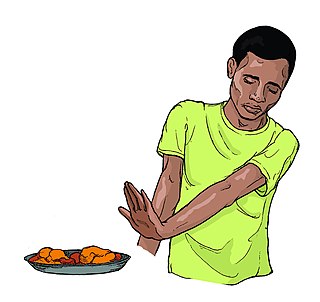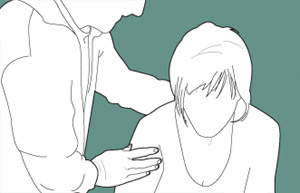
A phobia is an anxiety disorder, defined by a persistent and excessive fear of an object or situation. Phobias typically result in a rapid onset of fear and are usually present for more than six months. Those affected go to great lengths to avoid the situation or object, to a degree greater than the actual danger posed. If the object or situation cannot be avoided, they experience significant distress. Other symptoms can include fainting, which may occur in blood or injury phobia, and panic attacks, often found in agoraphobia and emetophobia. Around 75% of those with phobias have multiple phobias.

Anorexia is a medical term for a loss of appetite. While the term outside of the scientific literature is often used interchangeably with anorexia nervosa, many possible causes exist for a loss of appetite, some of which may be harmless, while others indicate a serious clinical condition or pose a significant risk.

Panic attacks are sudden periods of intense fear and discomfort that may include palpitations, sweating, chest pain or chest discomfort, shortness of breath, trembling, dizziness, numbness, confusion, or a feeling of impending doom or of losing control. Typically, symptoms reach a peak within ten minutes of onset, and last for roughly 30 minutes, but the duration can vary from seconds to hours. Although they can be extremely frightening and distressing, panic attacks themselves are not physically dangerous.
Glossophobia or speech anxiety is the fear of public speaking. The word glossophobia derives from the Greek γλῶσσα glossa (tongue) and φόβος phobos The causes of glossophobia are uncertain but explanations include communibiology and the illusion of transparency. Further explanations range from nervousness produced by a lack of preparation to, one of the most common psychiatric disorders, Social anxiety disorder (SAD).

Hypochondriasis or hypochondria is a condition in which a person is excessively and unduly worried about having a serious illness. Hypochondria is an old concept whose meaning has repeatedly changed over its lifespan. It has been claimed that this debilitating condition results from an inaccurate perception of the condition of body or mind despite the absence of an actual medical diagnosis. An individual with hypochondriasis is known as a hypochondriac. Hypochondriacs become unduly alarmed about any physical or psychological symptoms they detect, no matter how minor the symptom may be, and are convinced that they have, or are about to be diagnosed with, a serious illness.

Claustrophobia is the fear of confined spaces. It can be triggered by many situations or stimuli, including elevators, especially when crowded to capacity, windowless rooms, and hotel rooms with closed doors and sealed windows. Even bedrooms with a lock on the outside, small cars, and tight-necked clothing can induce a response in those with claustrophobia. It is typically classified as an anxiety disorder, which often results in panic attacks. The onset of claustrophobia has been attributed to many factors, including a reduction in the size of the amygdala, classical conditioning, or a genetic predisposition to fear small spaces.

Palpitations are perceived abnormalities of the heartbeat characterized by awareness of cardiac muscle contractions in the chest, which is further characterized by the hard, fast and/or irregular beatings of the heart.

Stage fright or performance anxiety is the anxiety, fear, or persistent phobia that may be aroused in an individual by the requirement to perform in front of an audience, real or imagined, whether actually or potentially. Performing in front of an unknown audience can cause significantly more anxiety than performing in front of familiar faces. In some cases, the person will suffer no such fright from this, while they might suffer from not knowing who they're performing to. In some cases, stage fright may be a part of a larger pattern of social phobia, but many people experience stage fright without any wider problems. Quite often, stage fright arises in a mere anticipation of a performance, often a long time ahead. It has numerous manifestations: stuttering, tachycardia, tremor in the hands and legs, sweaty hands, facial nerve tics, dry mouth, and dizziness.
Adjustment disorder is a maladaptive response to a psychosocial stressor. It is classified as a mental disorder. The maladaptive response usually involves otherwise normal emotional and behavioral reactions that manifest more intensely than usual, causing marked distress, preoccupation with the stressor and its consequences, and functional impairment.
Acute stress disorder is a psychological response to a terrifying, traumatic or surprising experience. It may bring about delayed stress reactions if not correctly addressed. Acute stress may present in reactions which include but are not limited to: intrusive or dissociative symptoms, and reactivity symptoms such as avoidance or arousal. Reactions may be exhibited for days or weeks after the traumatic event.

Rage is intense, uncontrolled anger that is an increased stage of hostile response to a perceived egregious injury or injustice.

Emergency psychiatry is the clinical application of psychiatry in emergency settings. Conditions requiring psychiatric interventions may include attempted suicide, substance abuse, depression, psychosis, violence or other rapid changes in behavior. Psychiatric emergency services are rendered by professionals in the fields of medicine, nursing, psychology and social work. The demand for emergency psychiatric services has rapidly increased throughout the world since the 1960s, especially in urban areas. Care for patients in situations involving emergency psychiatry is complex.
Phobophobia is a phobia defined as the fear of phobias, or the fear of fear, including intense anxiety and unrealistic and persistent fear of the somatic sensations and the feared phobia ensuing. Phobophobia can also be defined as the fear of phobias or fear of developing a phobia. Phobophobia is related to anxiety disorders and panic attacks directly linked to other types of phobias, such as agoraphobia. When a patient has developed phobophobia, their condition must be diagnosed and treated as part of anxiety disorders.
Stress-related disorders constitute a category of mental disorders. They are maladaptive, biological and psychological responses to short- or long-term exposures to physical or emotional stressors. The National Institute of Environmental Health Sciences categorizes Obsessive-Compulsive Disorder (OCD) and Post-Traumatic Stress Disorder (PTSD) as stress-related disorders. However, the World Health Organization's ICD-11 excludes OCD but categories PTSD, Complex Post-Traumatic Stress Disorder (CPTSD), adjustment disorder as stress-related disorders.
A sympatholytic (sympathoplegic) drug is a medication that opposes the downstream effects of postganglionic nerve firing in effector organs innervated by the sympathetic nervous system (SNS). They are indicated for various functions; for example, they may be used as antihypertensives. They are also used to treat anxiety, such as generalized anxiety disorder, panic disorder and PTSD. In some cases, such as with Guanfacine, they have also shown to be beneficial in the treatment of ADHD.

Stomach diseases include gastritis, gastroparesis, Crohn's disease and various cancers.

Nausea is a diffuse sensation of unease and discomfort, sometimes perceived as an urge to vomit. While not painful, it can be a debilitating symptom if prolonged and has been described as placing discomfort on the chest, abdomen, or back of the throat.
An anxiety threshold is the level of anxiety that, when reached, can affect a person's performance. Anxiety is an emotion, similar to fear, that can be created by insecurities in one's abilities, concerns for the future, such as financial or situational circumstances, or past memories of frightening experiences. Anxiety can affect all age groups and if fears are irrational, it may cause mental disorders. An individual's anxiety threshold can be measured by the amount of anxiety consistently manifested from situation to situation.
Falling-out is a culture-bound syndrome reported in Latin America and the Caribbean and usually brought on by stress.

Labile hypertension occurs when there are unexpected changes in blood pressure. The term can be used to describe when people have blood pressure measurements that abruptly fluctuates from being abnormally high, approximately 140/90mm Hg or over and returns to its normal range.











